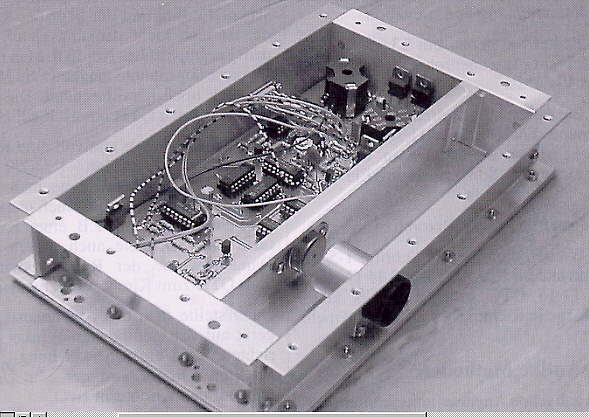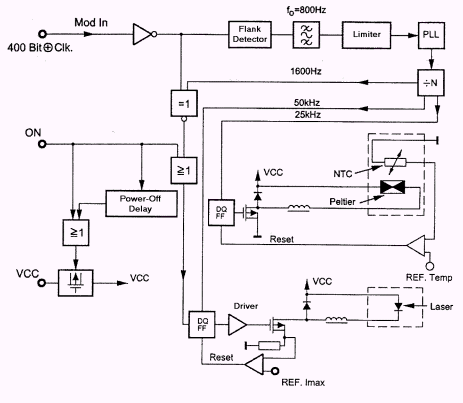K3PGP.Experimenter's.Corner
![]()
K3PGP.Experimenter's.Corner
![]()
Home Astronomy Construction Laser Moonbounce Software Guest Misc
Infrared Laser on P3-D
By Karl Meinzer, DJ4ZC, Dante Bauer
DH2FHB, Dick Jansson WD4FAB, Hermann Günther
AMSAT-dl Journal, 1/2000
Translated by Don Moe, KE6MN/DJ0HC

Case History
In the summer of 1999 the suggestion was made to expand the P3-D satellite with one more experiment: a “downlink” at 360,000 GHz. Initially it was very unclear whether such an exotic experiment could even be built.
Nevertheless, as a “precaution” a suitable location was identified for it in the satellite and a corresponding control cable was installed. Based on weight considerations, such an experiment seemed totally unfeasible since P3-D already had problems with its mass. However, during spin balancing of the satellite in the fall of 1999, it became apparent that such a laser module would fit right where balancing weights would be required. This realization triggered the actual start of work on the laser project.
A previous physics experiment supplied two Siemens infrared lasers (SFH 482403), which generate 0.5 W output power at a wavelength of 835 nm. These components are similar in appearance to TO-3 power transistors, but have a window in the cover for the light to exit at an angle of 10° x 20°. Additionally, each component contains a Peltier cooler for holding the laser temperature at 25° C, a temperature sensor and a photodiode for monitoring the light intensity.
Link Calculations
The feasibility basis for this experiment is the power balance of the signal path. First we must determine whether enough infrared light even reaches the ground to permit the laser to be received within the capabilities available to amateurs. The computation for the link is performed in a manner similar to radio links: at a prescribed distance of the satellite from the Earth, the transmitter illuminates a certain area on the ground. A small fraction of that energy will be collected by the surface of the receiving antenna and must be strong enough to rise sufficiently above the background noise. The calculation for this requires two steps: a) determine the minimal power required by the receiver in order to demodulate the signal; b) design antenna gains for the available transmitter power in order to actually achieve the minimal power at the receiver.
For this experiment the assumption was made that a maximum data rate of only 400 bits/s could be transmitted, such as our P3-D telemetry data, and that reception would only be possible at night under a clear sky, when no significant levels of other light would interfere with reception. Under these conditions, the atmosphere will absorb nearly 30% of the light and 70% will reach the ground. One further assumption is that a receiving antenna of 10-cm diameter should just suffice.
The achievable sensitivity of the receiver depends
largely on the available technology. At this point we made a
somewhat exotic assumption, namely that a detector of the
“photon counter” type with a high level of quantum
efficiency would be used. Such detectors exist in the form of
silicon avalanche photo diodes. Using such a detector,
approximately 10 photons are needed for each bit. Thus a signal
of 10-15 W can just be received. (Ne = h * c / lambda * 10 * 400
bit/s)
Under the conditions just described, this means that at an
average power level of 250 mW, e.g. 500 mW with 50% duty cycle
for modulation, the diameter of a target area on the ground can
be no larger than approximately 1,000 KM, in order for the signal
to still be receivable. A further calculation also shows that the
sunlight reflected by the satellite is at least 10 times weaker
under these conditions than the laser light and therefore causes
no interference.
At a distance of 50,000 KM, a target area of this diameter requires a beam divergence of approximately 1.2°. Since the available laser has a much larger aperture angle, a lens is needed. This lens initially proved to be difficult to obtain, but in December 1999 a suitable lens became available in Munich as surplus.
The module should be flight-ready by the end of March. In addition to modulation with a 400 bit/s data stream, the laser can also be keyed at a slow CW speed. Thus the laser can be observed with night vision equipment and messages could even be transmitted in Morse code.
Technical Implementation
In the adjoining block diagram, four functional groups can be identified:

1. Power Supply
Internally the module requires 10 V, which is switched on
by the onboard computer. The IR laser module includes a power-off
time delay of 5 seconds so that the laser can be keyed using the
power-on signal. Thus the circuit does not need to internally
restabilize (i.e. PLL) after each keying event.
2. Modulation
The engineering beacon (EB) of the satellite (400 bit/s
exclusive-OR with clock) is the primary clock signal to the PLL
for synchronizing all switching events. The EB signal is
exclusive-OR combined with a 1600 Hz carrier signal. This
modulation allows various improvements in the receiver design.
3. Laser Signaling
The laser is kept in the “on” state with a
constant current from a switching regulator running at 50 kHz.
This power converter is blocked for the “off” state.
The converter is fast enough to follow the keying signal without
significant flank degradation.
4. Peltier Cooler
Another power converter provides current to the cooler.
This current is controlled in accordance with the temperature of
the laser. The temperature sensing is done by an NTC, which is
built into the laser component.
Specifications
Frequency: 360,000
GHz¹
(approx. 835 nm)
Output Power:
250 mW average, 500 mW peak @ 50% duty cycle
Modulation: 1600
Hz square-wave carrier, BPSK modulated at 400 bit/s, same as P3-D
telemetry.
Radiation Properties:
Radiated direction:
Z axis of the satellite
Radiated shape:
approximately elliptical with 1/30 Rad width¹ (3 dB) in the
plane of the satellite X axis. 1/50 Rad width¹ (3 dB) in the
plane of the satellite Y axis.
Effective radiated area:
1/2000 sr (approx. 41 dBi “antenna gain”)
Polarization:
linear, E direction parallel to the satellite X axis¹.
Spectral properties:
multimode, approx. 2 nm bandwidth
¹ These
characteristics have not yet been finalized and are subject to
change. Updates will be published later.
Outlook
Naturally the laser experiment will primarily attract the experimenters among the amateurs. Due to the relatively small area of the illuminated zone on the ground, the operational times and the target zones must be predetermined and publicized.
In accordance with the schedule, the onboard computer
will aim the laser at the location on the ground by
correspondingly altering the satellite’s orientation.
After gaining some operational experience in orbit, we can decide
whether sufficient signal strength is available at apogee. If
not, the laser operating times can be moved to orbit intervals
when the satellite is closer to the Earth. Of course the
illuminated area on the ground will then be smaller.
Altogether we hope that the infrared laser in P3-D will offer
additional interesting possibilities for experimentation. To our
knowledge this will be the first laser downlink from a satellite.
Home Astronomy Construction Laser Moonbounce Software Guest Misc
Contents of this website are ©1995-2012 of K3PGP and of the originating authors.